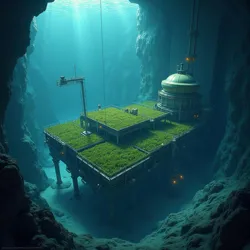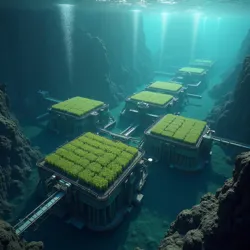Bathymetric Agriculture
 A Hsiungonix bathymetric agriculture facility utilizing pressure-resistant cultivation chambers at 5,000 meters depth
A Hsiungonix bathymetric agriculture facility utilizing pressure-resistant cultivation chambers at 5,000 meters depthBathymetric agriculture represents a revolutionary approach to deep-ocean food production that harnesses the unique conditions of abyssal environments for agricultural purposes. This specialized form of dark agriculture has emerged as a crucial technology for expanding humanity's food production capabilities while utilizing previously inaccessible oceanic resources. Pioneered by Hsiungonix Inc. in the early 2030s, bathymetric agriculture has transformed our understanding of extreme environment cultivation and marine resource utilization.
Technical Foundations
The core technology of bathymetric agriculture centers on pressure-resistant cultivation chambers that can withstand the intense hydrostatic pressures of deep ocean environments. These chambers employ advanced composite materials and biomimetic structural designs inspired by deep-sea organisms. The facilities typically operate at depths ranging from 2,000 to 10,000 meters, where they can take advantage of unique geological and chemical conditions unavailable at shallower depths.
Metabolic pathway engineering plays a crucial role in bathymetric agriculture, as crops must be specially adapted to function in high-pressure environments. Scientists have developed strains of plants that can process energy from various deep-sea mineral sources, particularly utilizing the abundant metallic compounds found near hydrothermal vents. These adaptations often involve the integration of pressure-tolerant genes from extremophile organisms and the development of specialized cellular structures that maintain integrity under extreme conditions.
Energy and Resource Systems
Bathymetric agricultural facilities typically employ multiple energy-gathering systems to power their operations. Deep thermal gradient harvesting utilizes the temperature differences between various ocean layers to generate electricity, while specialized piezoelectric systems capture energy from oceanic currents and tectonic activity. Many facilities are strategically positioned near hydrothermal vents, where they can harness geothermal energy and access mineral-rich water sources.
The unique chemical composition of deep ocean environments has led to the development of specialized nutrient extraction systems. These systems process minerals from hydrothermal vent emissions and utilize pressure-assisted extraction methods to create highly efficient growing mediums. The high pressure environment also enables novel approaches to gas exchange and nutrient delivery, often achieving efficiency levels impossible in surface-based agriculture.
 A network of cultivation chambers positioned around an active hydrothermal vent system
A network of cultivation chambers positioned around an active hydrothermal vent systemBiological Adaptations
Bathymetric agriculture relies heavily on bespoke microbiomes specifically engineered for deep ocean environments. These microbiological communities include pressure-tolerant bacteria and fungi that facilitate nutrient absorption and energy generation. Many of these organisms have been adapted from naturally occurring deep-sea species, creating unique symbiotic relationships that enhance crop productivity under extreme conditions.
The development of pressure-resistant plant varieties represents one of the most significant achievements in bathymetric agriculture. Through careful genetic engineering and selective breeding, scientists have created crops capable of maintaining cellular integrity and metabolic functions under intense pressure. These adaptations often incorporate mechanisms similar to those found in natural deep-sea organisms, such as pressure-stable membranes and modified protein structures.
Infrastructure and Implementation
Bathymetric agriculture facilities require sophisticated infrastructure to maintain optimal growing conditions. Pressure management systems carefully regulate the internal environment of cultivation chambers, while automated maintenance systems handle routine operations. Advanced materials science has enabled the development of transparent pressure vessels that can withstand enormous forces while allowing for visual monitoring of crops.
The facilities often incorporate modular designs that facilitate expansion and maintenance. Transportation systems utilizing specialized pressure-resistant vehicles and automated submersibles enable the movement of materials and products between different depth levels. These systems must operate with exceptional reliability, as equipment failures at extreme depths can be catastrophic.
Economic and Environmental Impact
The emergence of bathymetric agriculture has significantly influenced agricultural economic models and marine resource utilization strategies. By accessing previously unused ocean spaces, this technology has created new opportunities for food production while reducing pressure on terrestrial agricultural systems. The high efficiency of deep ocean cultivation, combined with the ability to operate year-round regardless of surface weather conditions, has made bathymetric agriculture an increasingly important component of global food security strategies.
Environmental considerations play a crucial role in bathymetric agriculture development. Facilities must be designed to minimize impact on deep ocean ecosystems while maximizing the benefits of natural marine processes. The technology has also contributed to our understanding of deep ocean environments and marine biology, leading to advances in ocean conservation and resource management.
Challenges and Future Developments
Despite its advantages, bathymetric agriculture faces several ongoing challenges. The extreme conditions of deep ocean environments pose continuous engineering challenges, particularly in maintaining long-term structural integrity and equipment reliability. The high costs associated with construction and maintenance of deep-sea facilities remain a significant barrier to wider adoption of the technology.
Current research focuses on developing more efficient pressure-resistant materials, improving energy harvesting systems, and creating new crop varieties optimized for deep ocean cultivation. Scientists are also exploring the potential of abyssal symbiosis systems that could create more self-sustaining agricultural operations by better integrating with natural deep-sea processes.
See Also
- Dark Agriculture
- Metabolic Pathway Engineering
- Piezoelectric Systems
- Global Food Security Strategies
References
- International Deep Ocean Cultivation Standards (2034)
- Journal of Extreme Environment Agriculture, Vol. 12 (2035)
- Bathymetric Agricultural Technology Review (2036)
- Deep Ocean Resource Management Quarterly (2037)